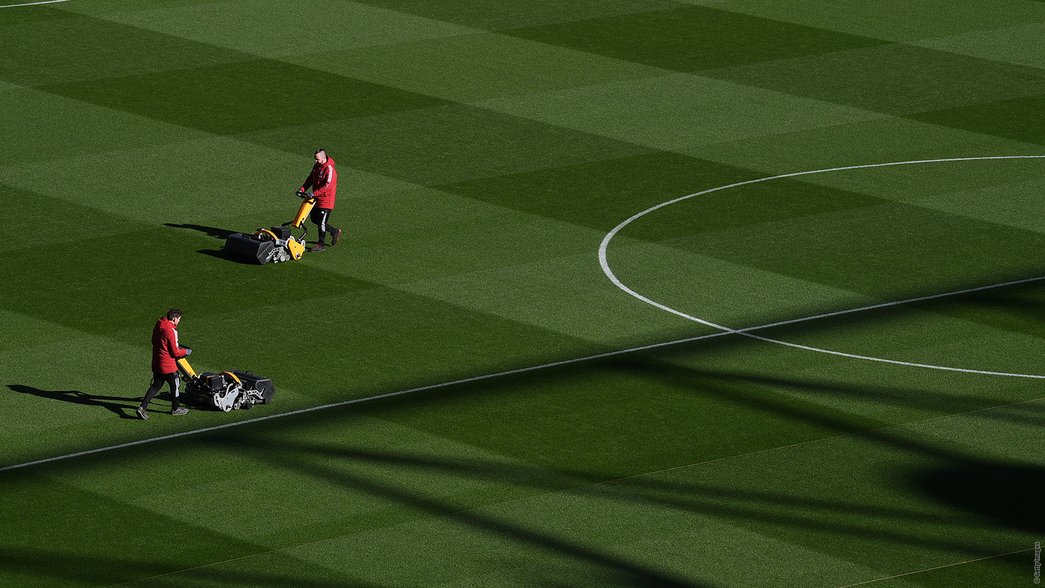The playing surface at Emirates Stadium, like Highbury before, has long been revered as one of the very best in the world. The team who produce this incredible pitch week in, week out aren’t just focusing on the pitch.
They have been using their considerable skills and expertise to try to improve the sustainability of this iconic piece of north London.
In 2016, electric cylinder mowers were introduced into the stadium. These mowers are used to ensure the grass is kept to the standard we have all grown accustomed to seeing. During the summer of 2020, we purchased new electric rotary mowers. Now those of you unfamiliar with the art of groundskeeping may wonder what the difference is. The cylinder mowers produce the laser-sharp lines on the pitch, whilst the rotary are the day to day workhorses.
The new electric rotary mowers are larger, boasting almost double the cutting deck, meaning pitch cutting time is reduced. Both electric types of mower have huge sustainability benefits by using electricity from our Electricity Partner, Octopus meaning 100 per cent renewable power, instead of the petrol-driven previous equipment. They are also almost silent running and greatly reduce vibration.
Being in north London, we are used to not having much sunlight. But the grass needs plenty of it to grow strong and we have to use artificial grow lights to supplement the natural sunlight. Pioneered at Highbury, these lights are an essential for the grounds team. They do, unfortunately use significant electricity, so we have been trialling new LED technology to replace the existing sodium lights. As you may know, grass enjoys red and blue light which can be created using LEDs, which is a light source that uses less power and is more efficient.
The existing sodium bulbs produce the whole lighting spectrum, creating some light that the grass doesn’t use. The only downside to LED lights in this application is that heat is not emitted. In our climate, supplementary heat needs to be added to enable us to speed up the recovery process and help us produce a surface of the highest standard and the sodium bulbs used in our current lights radiate heat which the plant needs during the winter months. There are alternative solutions to this, and ones which we have been working on. The technology is still being developed but we will be making sure we are at the forefront.
If you live close to the stadium, occasionally you may have noticed a strong garlic smell coming from Emirates Stadium. This is actually garlic, which is a natural, organic way of killing nematodes, a parasite that loves to feed on juicy grass roots. As well as using the garlic, this season we have trialled a new system of steaming the pitch which kills these unwelcome visitors, reducing the need to use products and chemicals. Arsenal were the first club to use this system on a stitched, hybrid pitch. The steaming also reduced the amount of pitch lighting needed as it helped our groundstaff establish the pitch quicker following the summer renovations, giving us a much-needed head start in our preparations.
Pitch management has become very technical and now very technological. The stadium pitch is constantly monitored and processes are increasingly data driven. This technology includes an on-site weather station, temperature and moisture probes providing constant information which is used to determine when the irrigation and undersoil heating systems are used. This technology ensures that we only irrigate when necessary. To make the pitch slick and ready for a game, the grass is watered but the drainage of the pitch is so good that it doesn’t get slippery. The use of technology and data monitoring has also reduced the use of fertilizers. Less fertilizer use means less being washed into the drains.
The production of a world class playing surface takes time and dedication, similar to being more sustainable!
Copyright 2023 The Arsenal Football Club plc. Permission to use quotations from this article is granted subject to appropriate credit being given to www.arsenal.com as the source.









